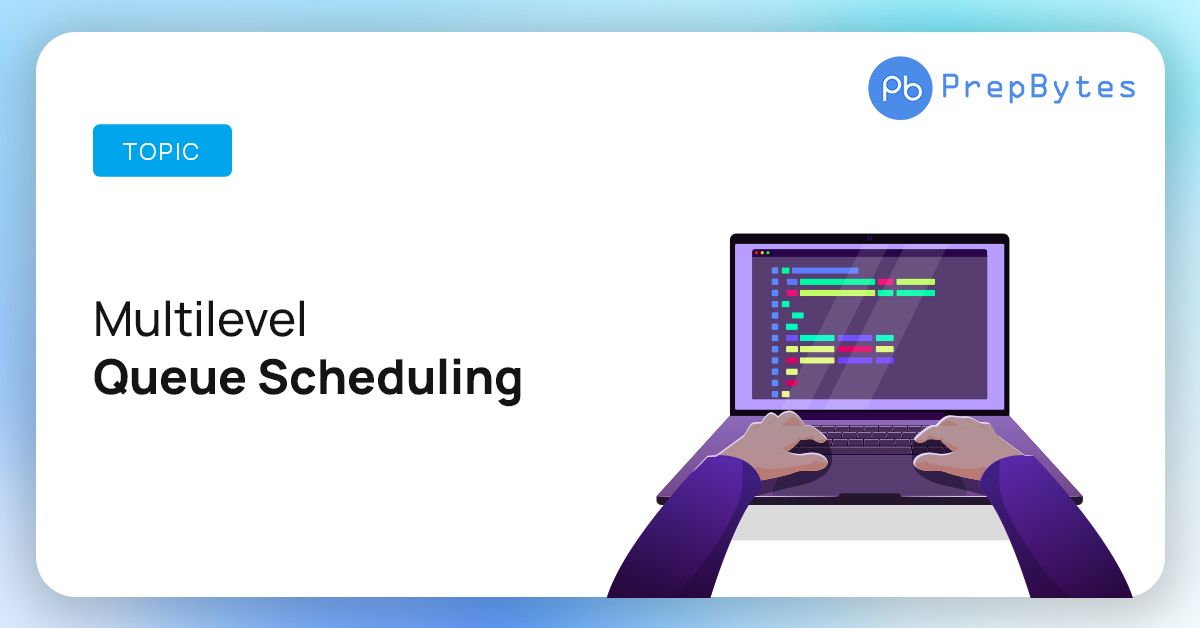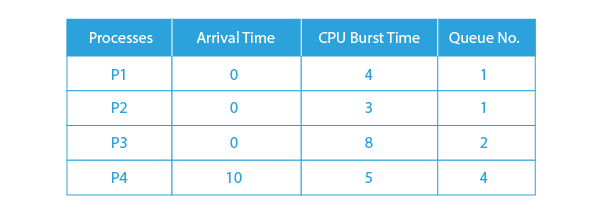Last Updated on July 20, 2023 by Mayank Dham

A multilevel queue scheduling algorithm divides the ready queue into multiple levels or tiers, each with a different priority. The appropriate level is then assigned to the processes based on their characteristics, such as priority, memory requirements, and CPU usage. In this article, we will go over the fundamentals of multilevel queue scheduling, as well as the benefits and drawbacks of multilevel queue scheduling and the concept of multilevel feedback scheduling.
What is Multilevel Queue Scheduling?
A method of organizing the tasks or processes that a computer must perform is multilevel queue scheduling. The computer system divides tasks or processes into different queues based on their priority in this method. A task’s priority can be determined by factors such as memory capacity, process priority, or type.
There are two main types of processes in the computer system: interactive processes and background processes. Interactive processes need to be done quickly because they are being used by a person, while background processes can wait because they are not as important.
In multilevel queue scheduling, there are different queues for the foreground (interactive) and background (batch) processes. The foreground processes need to be done quickly because they are being used by a person, while the background processes can wait because they are not as important.
Each queue has its own unique scheduling process. For example, the background queue can use a "first-come, first-served" technique to plan which task to do next, while the foreground queue can use a round-robin method.
Overall, multilevel queue scheduling helps the computer system manage its tasks more efficiently by prioritizing them based on their importance and using different scheduling techniques for different types of tasks.
Example of Multilevel Queue Scheduling
To further understand how this scheduling operates, let’s look at an example of a multilevel queue-scheduling algorithm with five queues:

- System process
- Interactive processes
- Interactive editing processes
- Batch processes
- Student processes
Every queue would take precedence over queues with lower priorities. Until the high-priority queues are empty, no process may proceed. No other process may run in the scenario mentioned above until the system, interactive, and editing process queues are empty. A batch process will be preempted if an interactive editing process joins the ready queue while one is already running.
The following are descriptions of the procedures utilized in the example above:
System Process
The OS has its own process to run, known as the System Process.
Interactive Process
The System Process, a process that the OS has to run, is known as such.
Batch Process
An operating system function called batch processing gathers applications and data into a batch before processing begins.
Student Process
The system process is consistently given top priority, whereas the student procedures are consistently given bottom priority.
Advantages of Multilevel Queue Scheduling
In comparison to other scheduling algorithms, multilevel queue scheduling has several advantages. Some of these advantages are
- Efficient Resource Utilization: Multilevel queue scheduling allows the system to allocate resources more efficiently by grouping processes with similar resource requirements into separate queues.
- Improved Response Time: By assigning higher priority to interactive processes that require a fast response time, multilevel queue scheduling can reduce response time and improve system performance.
- Better Throughput: Multilevel queue scheduling can improve the overall throughput of the system by executing processes more efficiently. The system can execute multiple processes concurrently from different queues, improving the overall efficiency of the system.
- Flexibility: Multilevel queue scheduling can be customized to suit different types of applications or workloads by adjusting the priority levels of the queues. This allows the system to adapt to changing workload demands, ensuring that resources are allocated efficiently.
- Fairness: Multilevel queue scheduling can provide a fair allocation of CPU time to all processes by ensuring that each queue is executed in turn. This can prevent any single process from monopolizing the CPU and starving other processes of CPU time.
Disadvantages of Multilevel Queue Scheduling:
While multilevel queue scheduling has several advantages, there are also some drawbacks to using this algorithm. Here are some of them:
- Complexity: Multilevel queue scheduling is a relatively complex scheduling algorithm that can be difficult to implement and manage. The system needs to maintain multiple separate queues with different priority levels, which can be challenging to maintain.
- Overhead: Dividing the ready queue into multiple queues can increase the overhead associated with the scheduling algorithm, which can negatively impact system performance.
- Inflexibility: The fixed priority levels of multilevel queue scheduling may not be suitable for all types of applications or workloads. Some applications may require more or less CPU time than the priority level assigned to them, which can result in inefficient resource allocation.
- Starvation: If a queue has a large number of processes with a higher priority than those in other queues, the processes in the lower-priority queues may be starved of CPU time.
Overall, while multilevel queue scheduling has its advantages, such as improved system performance and efficient resource utilization, it also has its limitations and drawbacks. These disadvantages need to be considered when selecting a scheduling algorithm for a particular system.
Example of Multilevel Queue Scheduling
Let’s take an example that explains how Multilevel Queue Scheduling works.

As shown in the preceding table, Queue 1 has a higher priority than Queue 2, and Round Robin is used in Queue 1 (Time Quantum=2), whereas first come, first served is used in Queue 2.
Lets see the GANT CHART:

Working:
Both queues are processed from the beginning. As a result, queues (P1, P2) run first (due to higher priority) in a Round Robin manner, with 1 finishing after 7 units. Because there are no processes in Queue 1, the process in Queue 2 (Process P3) starts running, but while it is running, P4 enters Queue 1 and interrupts P3, and then P3 takes the CPU and completes the execution.
Multilevel Feedback Scheduling
Multilevel feedback scheduling is a way of managing tasks or processes in a computer system. In this method, tasks are divided into different queues based on their priority, and each queue has its own scheduling algorithm.
Unlike the multilevel queue scheduling method, where tasks are fixed in a particular queue, the multilevel feedback scheduling method allows tasks to move between different queues based on their behavior. For example, if a task uses too much processing time, it will be moved to a lower-priority queue. Similarly, if a task waits in a lower-priority queue for too long, it may be moved to a higher-priority queue.
In the multilevel feedback scheduling method, interactive tasks that require input and output are given higher priority. This method also includes a process for deciding when to demote a task to a lower-priority queue and when to upgrade it to a higher-priority queue.
The following are the multilevel feedback queue scheduler’s parameters:
- The system’s scheduling method for each queue.
- the system’s queue number
- the process for deciding when to demote a queue to a lower-priority queue.
- This process chooses the time at which it is upgraded to a higher priority queue.
- The procedure for choosing which processes will be added to the queue and when they will need service.
Conclusion
A popular scheduling algorithm is multilevel queue scheduling, which can efficiently allocate resources to processes based on their priority levels. Despite its benefits, it has some drawbacks, such as complexity and the possibility of starvation. However, by allowing processes to move between queues based on their behavior, multilevel feedback scheduling can address some of these limitations. Overall, multilevel queue scheduling is still a useful scheduling algorithm in many modern computer systems.
Frequently Asked Questions
Here are some frequently asked questions on multilevel queue scheduling.
Q1: What is the difference between multilevel queue scheduling and multilevel feedback scheduling?
Ans: Multilevel feedback scheduling is a variant of multilevel queue scheduling in which processes can move between queues based on their behavior. Multilevel queue scheduling gives each process a fixed priority and executes the processes in each queue in turn.
Q2: What is the purpose of dividing the ready queue into multiple queues?
Ans: By dividing the ready queue into multiple queues, the system can more efficiently allocate resources by grouping processes with similar resource requirements into separate queues.
Q3: How does multilevel queue scheduling ensure fairness?
Ans: By executing each queue in turn, multilevel queue scheduling ensures fairness. This prevents one process from monopolizing the CPU and depriving other processes of CPU time.
Q4: Can a process move between queues in multilevel queue scheduling?
Ans: In multilevel queue scheduling, a process cannot move between queues. A process’s priority is fixed, and it stays in the same queue throughout its execution.
Q5: How does multilevel queue scheduling handle I/O-bound processes?
Ans: I/O-bound processes are handled by multilevel queue scheduling, which assigns them to the highest priority queue with the shortest time quantum. This ensures that the process responds quickly.
Q6: Can multilevel queue scheduling prevent starvation?
Ans: Multilevel queue scheduling can prevent starvation by ensuring that each queue is executed in turn. This prevents any single process from monopolizing the CPU and starving other processes of CPU time.


